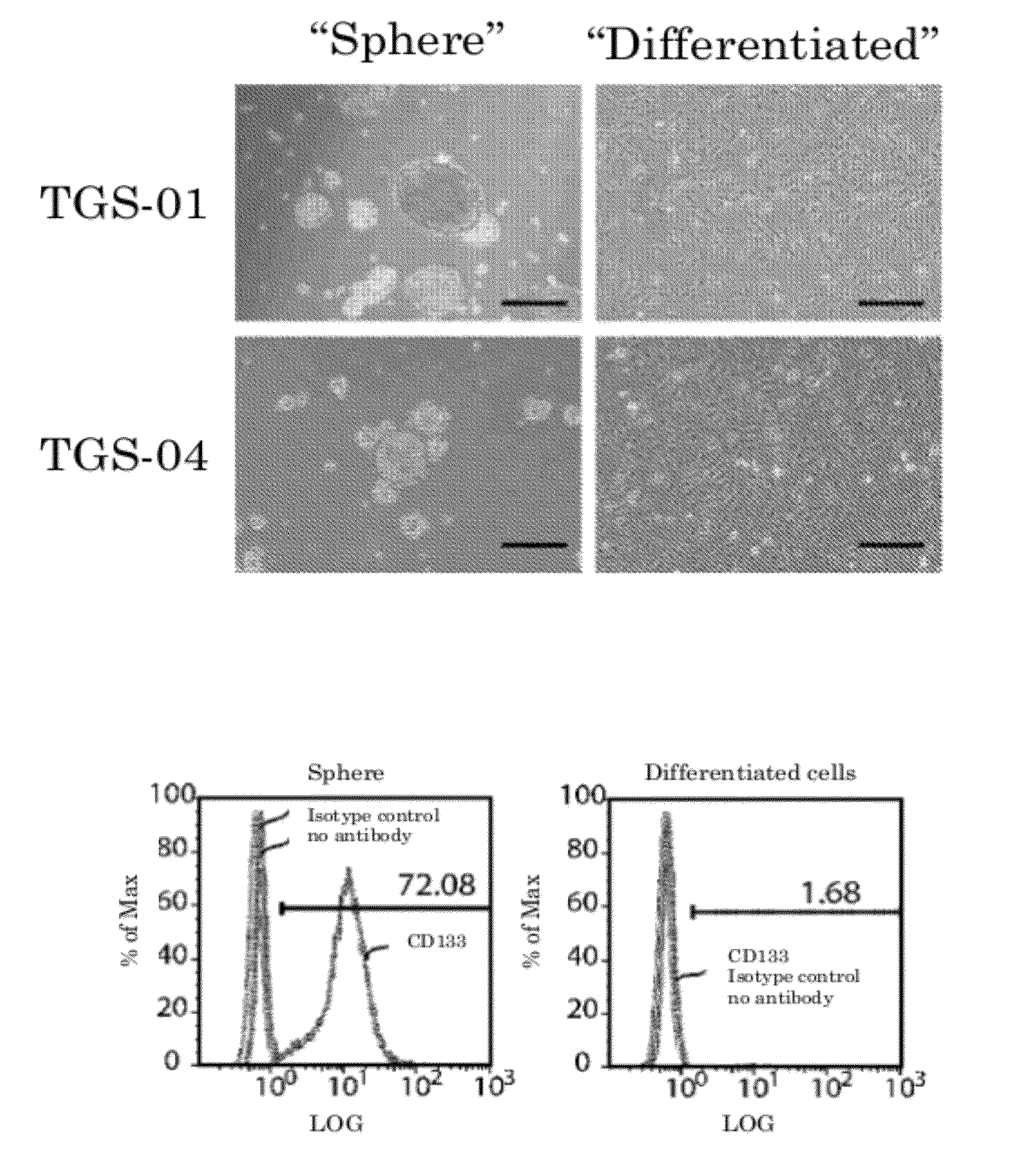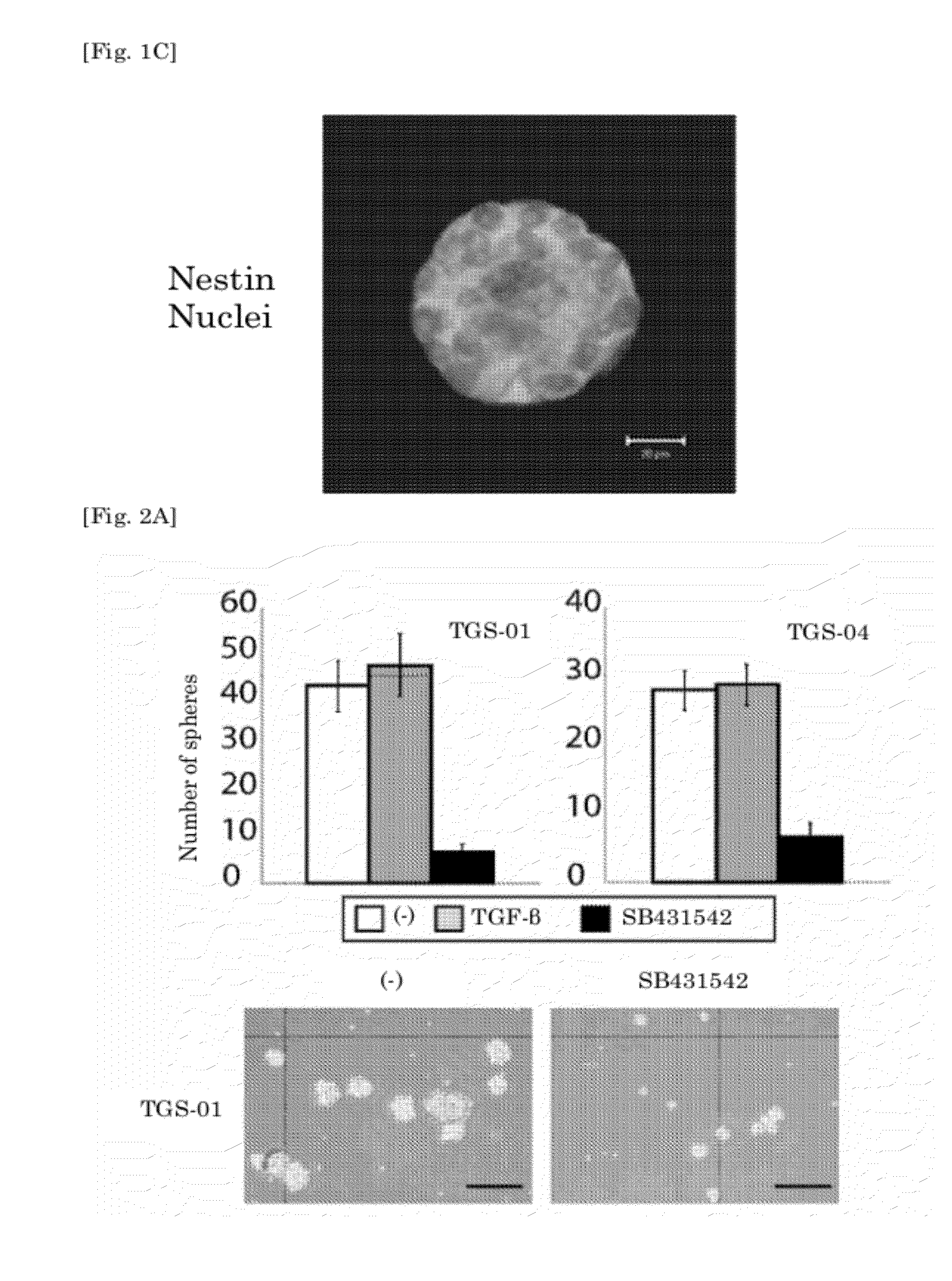Brain Tumor Stem Cell Differentiation Promoter, and Therapeutic Agent for Brain Tumor
- Summary
- Abstract
- Description
- Claims
- Application Information
AI Technical Summary
Benefits of technology
Problems solved by technology
Method used
Image
Examples
implementation example 1
Regulation of Glioma Sphere and Differentiated Glioma Cells, and Evaluation of their Characteristics
[0129]To clarify the mechanism by which glioma stem cellularity is maintained, TGS-01 and TGS-04 were first cultured in serum-free culture as described above to obtain spheres.
[0130](See FIG. 1A Left.) Both had self-renewal abilities, and showed similar action to that of the original cancer when transplanted into the brains of immunosuppressed mice. On the other hand, when the same samples were cultivated in 10% fetal bovine serum, the spheres did not form. (See FIG. 1A Right.) Cells cultivated in this way are sometimes called “differentiated glioma cells” or “differentiated cells” below.
[0131]CD133 (Prominin-1) has been reported as a glioma-initiating cell marker. (See non-patent document 1.) Here, the cells were separated into single cells, and the CD133 expression levels measured using flow cytometry. The results are shown in FIG. 1B. An increase in the percentage of CD133-positive...
implementation example 3
Maintenance of Stem Cellularity in Glioma-Initiating Cells by Sox2, and the Induction of Sox2 Expression due to TGF-β
[0139]To clarify the mechanism by which the stem cellularity of glioma-initiating cells is maintained by TGF-β signals, the effects of TGF-β and 31542 on the expression of stem cell markers were examined.
[0140]The results are shown in FIG. 4A. The expression of Sox2 mRNA, which is a HMG-box factor, was induced 24 hours after processing using TGF-β (100 μM), but when using SB431542 (1 μg), Sox2 expression was suppressed after 24 hours, and the low expression level continued subsequently for seven days.
[0141]In contrast, the expression of other pluripotent stem cell-related molecules such as Oct-4, NANOG, and LIF, etc., were not greatly affected by processing using TGF-β or an inhibitor. (See FIG. 14.) Further, it has been reported that NANOG and LIF are induced in many cells by stimulating TGF-β. (Xu et al., Cell Stem Cell, 2008, 3: 206; Bruna et al., Cancer Cell, 2007...
implementation example 4
Effects of TGF-β Inhibitors on Cells that Over-Express Sox2
[0148]To investigate more deeply the role of Sox2 in maintaining stem cell cellularity due to TGF-β, adenovirus coated with Sox2 cDNA was stained, and the effects of TGF-β inhibition on glioma-initiating cells that had been made to over-express Sox2 was examined.
[0149]Even if SB431542 was administered to glioma-initiating cells that had been made to over-express Sox2, sphere formation abilities were reduced only slightly compared to cells that had been made to over-express LacZ. (See FIG. 5A.) Further, even if SB431542 was administered to cells that over-expressed Sox2, from the fact that the percentage of Nestin-positive cells did not fall, and the percentage of GFAP-positive cells did not increase (see FIG. 5A), it was determined that glioma cells maintain stem cellularity.
[0150]From these results, it was understood that loss of stem cellularity using TGF-β inhibitors was due to the down-regulation of Sox2, which maintains...
PUM
| Property | Measurement | Unit |
|---|---|---|
| Therapeutic | aaaaa | aaaaa |
| Level | aaaaa | aaaaa |
Abstract
Description
Claims
Application Information
 Login to View More
Login to View More - R&D
- Intellectual Property
- Life Sciences
- Materials
- Tech Scout
- Unparalleled Data Quality
- Higher Quality Content
- 60% Fewer Hallucinations
Browse by: Latest US Patents, China's latest patents, Technical Efficacy Thesaurus, Application Domain, Technology Topic, Popular Technical Reports.
© 2025 PatSnap. All rights reserved.Legal|Privacy policy|Modern Slavery Act Transparency Statement|Sitemap|About US| Contact US: help@patsnap.com



